 W
WThis is a list of notable butter dishes and foods in which butter is used as a primary ingredient or as a significant component of a dish or a food. Butter is a dairy product that consists of butterfat, milk proteins, and water. It is made by churning fresh or fermented cream or milk.
 W
WAligot is a dish made from cheese blended into mashed potatoes that is made in L'Aubrac region in the southern Massif Central of France. This fondue-like dish from the Aveyron department is a common sight in the Auvergne.
 W
WBéarnaise sauce is a sauce made of clarified butter emulsified in egg yolks and white wine vinegar and flavored with herbs. It is considered to be a "child" of the mother Hollandaise sauce, one of the five mother sauces in the French haute cuisine repertoire. Béarnaise uses shallot, chervil, peppercorns, and tarragon in a reduction of vinegar and wine, while Hollandaise is more stripped down, using a reduction of lemon juice or white wine. The means of preparing Béarnaise, see below, are to start with Hollandaise and add the other ingredients. Its name is related to the province of Béarn, France.
 W
WBread and butter pudding is a traditional bread pudding popular in British cuisine. Slices of buttered bread scattered with raisins are layered in an oven dish, covered with an egg custard mixture seasoned with nutmeg, vanilla or other spices, then baked.
 W
WA butter cake is a cake in which one of the main ingredients is butter. Butter cake is baked with basic ingredients: butter, sugar, eggs, flour, and leavening agents such as baking powder or baking soda. It is considered as one of the quintessential cakes in American baking. Butter cake originated from the English pound cake, which traditionally used equal amounts of butter, flour, sugar, and eggs to bake a heavy, rich cake.
 W
WButter chicken curry or murgh makhani is a curry of chicken in a spiced tomato, butter and cream sauce. It originated in India as a curry.
 W
WButter cookies, known as Brysselkex, Sablés, and Danish biscuits, are unleavened cookies consisting of butter, flour, and sugar. They are often categorized as a "crisp cookie" due to their texture, caused in part because of the quantity of butter and sugar. It is generally necessary to chill the dough to enable proper manipulation and handling. Butter cookies at their most basic have no flavoring, but they are often flavored with vanilla, chocolate, and coconut, and/or topped with sugar crystals. They also come in a variety of shapes such as circles, squares, ovals, rings, and pretzel-like forms, and with a variety of appearances, including marbled, checkered or plain. Using piping bags, twisted shapes can be made. In some parts of the world, such as Europe and North America, butter cookies are often served around Christmas time. Butter cookies are also a very popular gift in China, especially during Chinese New Year.
 W
WButter pecan is a flavor, prominent especially in the United States, in cakes, cookies, and ice cream. Roasted pecans, butter, and vanilla flavor are used in butter pecan baked goods. Butter pecan ice cream is smooth vanilla ice cream with a slight buttery flavor, with pecans added. It is manufactured by many major ice cream brands. A variant of the recipe is butter almond, which replaces the pecans with almonds.
 W
WButter salt is a seasoning developed in the late twentieth century for the purpose of combining the flavours found in salt and butter. It is a fine, golden powder, originally salt, enriched with butter flavouring. It is often used as a seasoning for popcorn. It is said to impart a "rich, buttery flavour".
 W
WA butter tart is a type of small pastry tart highly regarded in Canadian cuisine and considered one of Canada's quintessential treats. The sweet tart consists of a filling of butter, sugar, syrup, and egg, baked in a pastry shell until the filling is semi-solid with a crunchy top. The butter tart should not be confused with butter pie or with bread and butter pudding.
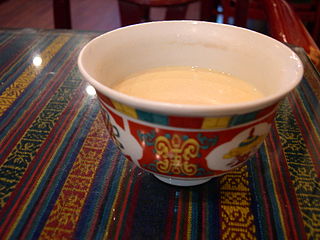 W
WButter tea, also known as po cha, cha süma, Mandarin Chinese: sūyóu chá (酥油茶) or gur gur cha in the Ladakhi language, is a drink of the people in the Himalayan regions of Nepal, Bhutan, India and Tibet and other Western regions of modern-day People's Republic of China. Traditionally, it is made from tea leaves, yak butter, water, and salt, although butter made from cow's milk is increasingly used, given its wider availability and lower cost.
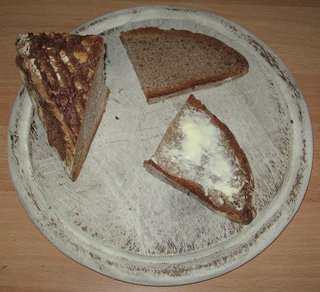 W
WThe German word Butterbrot describes a slice of bread topped with butter. The words in formal and colloquial German and the different dialects for butterbrot, simply Brot ("bread"), Butterstulle, Stulle, Schnitte, Botteramm, Bütterken to Bemme or Knifte (Ruhrdeutsch). Although it is increasingly replaced by other foods, it remains a common staple food in Germany. Since 1999, the last Friday in the month of September was made the day of butterbrot by the Marketing Organization of German Agricultural Industries. Russian adopted the term buterbrod (бутерброд) from New High German (Butterbrot), perhaps as early as the 17th century during the reign of Peter the Great. In modern Russian the term has a more general meaning, whatever the ingredient on top of the slice of bread is. From Russian, the term buterbrod was adopted into Azerbaijani, Belarusian, Georgian, Kazakh, Ukrainian, and Lithuanian.
 W
WButtercream, also referred to as butter icing, is used either filling, coating or decorating cakes.
 W
WButterkist is the United Kingdom's best-selling brand of popcorn, with around 40% of the £90 million market.
 W
WButterkuchen or Zuckerkuchen is a simple German butter cake baked on a tray. Flakes of butter are distributed on the dough which, after baking, form the characteristic holes. The whole cake is sprinkled with sugar or streusel. After further kneading the Butterkuchen is baked. As a variation the dough can be sprinkled with roasted almond flakes.
 W
WButtermilk pie is a pie in American cuisine. Associated with the cuisine of the Southern United States, it is one of the desperation pies, made using simple, staple ingredients.
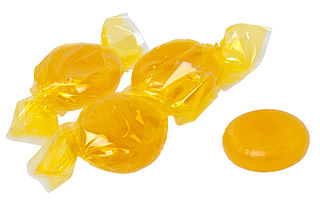 W
WButterscotch is a type of confectionery whose primary ingredients are brown sugar and butter, but other ingredients are part of some recipes, such as corn syrup, cream, vanilla, and salt. The earliest known recipes, in mid-19th century Yorkshire, used treacle (molasses) in place of or in addition to sugar.
 W
WA buttery, also known as a rowie or Aberdeen roll, is a savoury bread roll originating from Aberdeen, Scotland.
 W
WChicken Chettinad or Chettinad chicken is a classic Indian recipe, from the cuisine of Chettinad. It consists of chicken marinated in yogurt, turmeric and a paste of red chillies, kalpasi, coconut, poppy seeds, coriander seeds, cumin seeds, fennel seeds, black pepper, ground nuts, onions, garlic and gingelly oil. It is served hot and garnished with coriander leaves, accompanied with boiled rice or paratha.
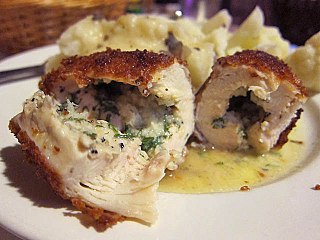 W
WChicken Kiev is a dish made of chicken fillet pounded and rolled around cold butter, then coated with eggs and bread crumbs, and either fried or baked. Stuffed chicken breast is generally known in Ukrainian and Russian cuisines as côtelette de volaille. Since fillets are often referred to as suprêmes in professional cookery, the dish is also called suprême de volaille à la Kiev. Though it has disputed origins, the dish is particularly popular in the Post-Soviet states, as well as in several other countries of the former Eastern Bloc, and in the English-speaking world.
 W
WCookie butter is a food paste made primarily from speculoos cookie crumbs, fat, flour, and sugar. The ingredients are mixed until it becomes spreadable on a sandwich. In countries like Belgium, the Netherlands, and France, it is a common alternative to nut butter and chocolate spreads. The most common brand name is Lotus Bakeries.
 W
WA croissant is a buttery, flaky, viennoiserie pastry of Austrian origin, named for its historical crescent shape. Croissants and other viennoiserie are made of a layered yeast-leavened dough. The dough is layered with butter, rolled and folded several times in succession, then rolled into a thin sheet, in a technique called laminating. The process results in a layered, flaky texture, similar to a puff pastry.
 W
WA Danish pastry, sometimes shortened to just Danish, is a multilayered, laminated sweet pastry in the viennoiserie tradition. The concept was brought to Denmark by Austrian bakers, and has since developed into a Danish specialty. Like other viennoiserie pastries, such as croissants, it is a variant of puff pastry made of laminated yeast-leavened dough that creates a layered texture.
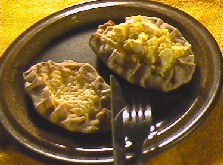 W
WEgg butter is a mixture of butter and chopped hard boiled eggs. It is a well known spread in Finnish cuisine and Estonian cuisine.
 W
WGarlic butter, also known as beurre à la bourguignonne, is a compound butter used as a flavouring for Escargots à la bourguignonne. It is also spread on bread or used in shrimp scampi. It is composed of butter and garlic pounded into a paste. These ingredients are well blended and chilled before use.
 W
WHard sauce is a sweet, rich dessert sauce made by creaming or beating butter and sugar with rum, brandy, whiskey, sherry, vanilla or other flavourings. It is served cold, often with hot desserts.
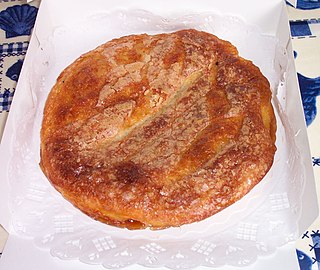 W
WKouign-amann is a Breton cake, described in the New York Times as "the fattiest pastry in all of Europe." The name comes from the Breton language words for cake (kouign) and butter (amann). It is a round multi-layered cake, originally made with bread dough, containing layers of butter and sugar folded in, similar in fashion to puff pastry albeit with fewer layers. The cake is slowly baked until the butter puffs up the dough and the sugar caramelizes. The effect is similar to a muffin-shaped, caramelized croissant.
 W
WThe Linzer torte is a traditional Austrian pastry, a form of shortcake topped with fruit preserves and sliced nuts with a lattice design on top. It is named after the city of Linz, Austria.
 W
WMacaroni and cheese—also called mac 'n' cheese in the United States, and macaroni cheese in the United Kingdom—is a dish of cooked macaroni pasta and a cheese sauce, most commonly cheddar. It can also incorporate other ingredients, such as breadcrumbs, meat and vegetables.
 W
WPain aux raisins or escargot is a spiral pastry often eaten for breakfast in France. Its names translate as "raisin bread" and "snail", respectively. It is a member of the pâtisserie viennoise family of baked foods.
 W
WPotted shrimps are a traditional British dish made with brown shrimp flavored with nutmeg. The dish consists of brown shrimp in nutmeg-flavoured butter, which has set in a small pot, the butter acting as a preservative. Cayenne pepper may also be included. It is traditionally eaten with bread.
 W
WA Pozharsky cutlet is a breaded ground chicken or veal patty that is typical for Russian cuisine. A distinct feature of this cutlet is adding butter to minced meat which results in an especially juicy and tender consistency. The dish was created in the beginning of the 19th century in Russia and later adopted by French haute cuisine.
 W
WPuff pastry, also known as pâte feuilletée, is a flaky light pastry made from a laminated dough composed of dough and butter or other solid fat. The butter is put inside the dough, making a paton which is repeatedly folded and rolled out before baking.
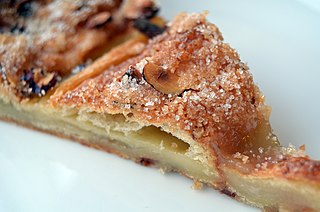 W
WRemonce is a creamy combination made from mixing creamed butter, flavored paste and sugar. It is used as a filling in various traditional Danish pastries and is baked along with the pastry. Remonce spread is sometimes flavored with cinnamon, cardamom, marzipan, or almond paste.
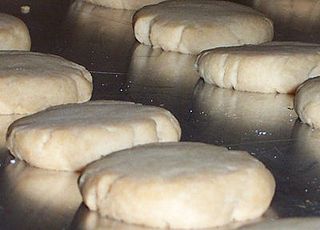 W
WShortbread is a traditional Scottish biscuit usually made from one part white sugar, two parts butter, and three to four parts plain wheat flour. Other ingredients such as rice flour or cornflour are often substituted for part of the flour to alter the texture. Modern recipes also often deviate from the original by splitting the sugar into equal parts granulated and icing sugar and many add a portion of salt. Unlike many other biscuits and baked goods, shortbread does not contain any leavening, such as baking powder or baking soda. Shortbread is widely associated with Christmas and Hogmanay festivities in Scotland, and some Scottish brands are exported around the world.
 W
WA Shrewsbury cake or Shrewsbury biscuit is a classic English dessert, named after Shrewsbury, the county town of Shropshire. They are made from dough that contains sugar, flour, egg, butter and lemon zest; dried fruit is also often added. Shrewsbury cakes can be small in size for serving several at a time, or large for serving as a dessert in themselves.
 W
WSmørrebrød is a traditional Scandinavian open-faced sandwich that usually consists of a piece of buttered rye bread, a dense, dark brown bread, topped with commercial or homemade cold cuts, pieces of meat or fish, cheese or spreads, and garnishes.
 W
WTetrazzini is an American dish made with diced poultry or seafood and mushroom in a butter/cream and cheese sauce flavored with wine or sherry. It is served hot over linguine, spaghetti, egg noodles, or some other types of pasta, garnished with parsley, and sometimes topped with breadcrumbs, almonds, canned fried onions, or cheese. Tetrazzini can be prepared as a baked noodle casserole, sometimes with steps taken to give it a browned crust. Shortcut recipes for home cooking sometimes use canned cream of mushroom soup or other cream soups.
 W
WA torpedo dessert is a buttery, flaky viennoiserie bread roll, filled with pastry cream, named for its well-known torpedo shape. Croissants and other viennoiserie are made of a layered yeast-leavened dough. The dough is layered with butter, rolled and folded several times in succession, then rolled into a sheet, in a technique called laminating. The process results in a layered, flaky texture, similar to a puff pastry.